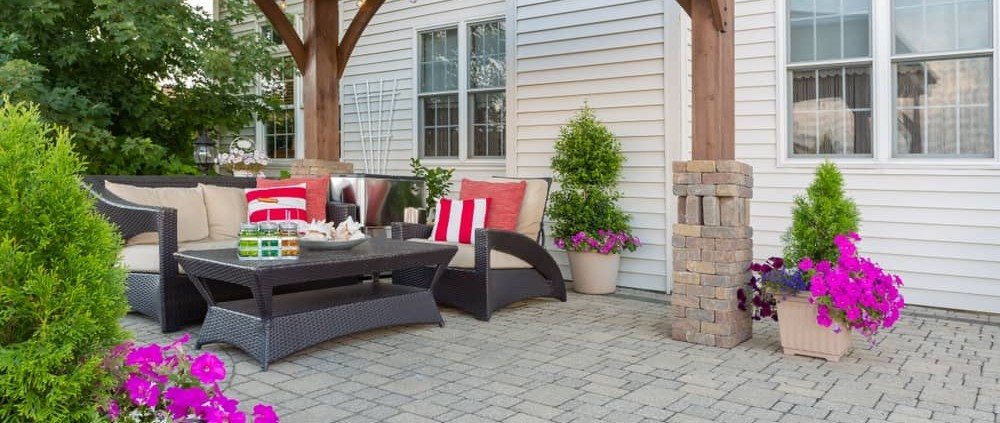Does Pavers Increase Home Value?
Enhancing the value of a home is a goal for many homeowners, and one effective way to achieve this is through thoughtful improvements and renovations. Among the various options available, the installation of pavers stands out as a particularly impactful choice. Pavers, which come in a variety of materials like stone, concrete, and brick, offer a blend of aesthetic appeal and functionality, significantly boosting the attractiveness and utility of outdoor spaces. This guide explores the various facets of pavers as a home improvement tool, from their impact on curb appeal and home value to design considerations and maintenance.
What are Pavers?
Pavers are a versatile and durable landscaping material used to create outdoor surfaces such as driveways, walkways, and patios. They come in several types, including natural stone, concrete, and brick, each offering its unique aesthetic and functional benefits. Stone pavers, with their natural appearance, add a touch of elegance, while concrete pavers offer a more modern look and are often more cost-effective. Brick pavers, known for their classic charm, are perfect for adding a traditional touch to any property. The use of pavers in landscaping is not just about beauty; they are also highly durable, easy to repair, and offer excellent drainage, making them a practical choice for any outdoor space.
The Impact of Pavers on Curb Appeal
Curb appeal is the attractiveness of a property as viewed from the street, and pavers play a crucial role in enhancing this appeal. A well-designed paver driveway or walkway can transform the look of a property, making it more inviting and appealing. The versatility of pavers allows for a range of designs, from simple and elegant patterns to intricate and artistic layouts, catering to diverse aesthetic preferences. Whether it’s a sleek, modern driveway or a quaint, cobblestone-like walkway, pavers can significantly elevate the visual appeal of a property.
Pavers and Home Value
Real estate experts often highlight the positive impact of well-executed landscaping on home value, and pavers are a critical component of this. Paver installations can offer a significant return on investment (ROI). For example, certain studies and case studies have shown that high-quality landscaping with elements like pavers can increase a home’s value by a notable percentage. This increase is not just in monetary terms; pavers also make a property more appealing to potential buyers, potentially reducing the time it spends on the market.
Design Considerations with Pavers
Choosing the right paver style and color is crucial in complementing the home’s architecture and the overall landscape design. When selecting pavers, consider the color scheme of the home and its surroundings. Neutral colors often offer versatility, while vibrant or contrasting pavers can create a focal point. The layout and pattern of the pavers also play a significant role. Herringbone, basketweave, and running bond are popular patterns, each offering a different aesthetic appeal. For those seeking something unique, custom designs and mixed materials can provide a distinctive look.
Installation and Maintenance
The installation of pavers is a detailed process that involves preparing the base, laying the pavers, and filling the joints with sand or other materials. While it is possible for a skilled DIYer to undertake this project, professional installation is recommended to ensure longevity and optimal performance. Maintenance of pavers is relatively straightforward. Regular cleaning, occasional sealing, and prompt repair of any displaced or damaged pavers can keep the installation looking pristine and functioning well for years.
Cost vs. Value Analysis
The cost of installing pavers varies depending on the type of material, the complexity of the design, and the project’s scale. While the upfront cost can be significant, especially for high-end materials like natural stone, the long-term value addition should be considered. Pavers are a durable choice and can enhance the property’s value, making them a worthwhile investment. Homeowners should weigh the initial costs against the potential increase in property value and the aesthetic and functional benefits.
Case Studies
Real-life examples provide valuable insights into the impact of pavers on home value. Homes that have undergone paver installations often see a marked increase in curb appeal and market value. Interviews with homeowners and real estate professionals can attest to the transformative effect of a well-executed paver project, both in terms of aesthetics and financial returns.
Conclusion
Pavers are more than just a decorative element; they are a strategic investment in a property’s value and appeal. From enhancing curb appeal to offering a high ROI, the benefits of paver installations are clear. When chosen and installed correctly, they can significantly elevate a property’s look and worth.




